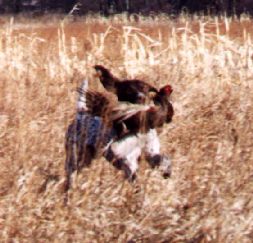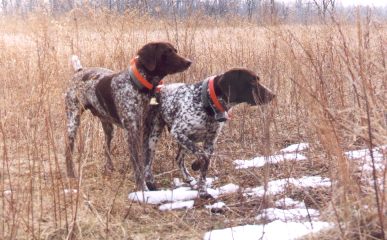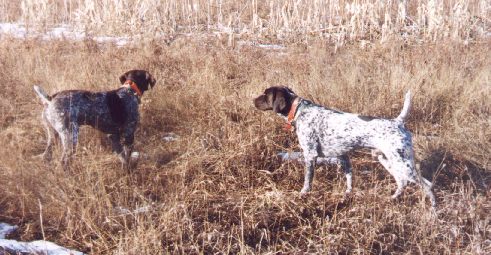
The day was beautiful, sunny, 40F, a gentle breeze generally out of the south, but occasionally shifting. Here is the first bird, Manfred on point, Remington honoring. This was a day of excellent teamwork by both dogs, honoring each other's finds, and retrieving every bird.

Manfred returns the favor, honoring Remy's point.


I did say they retrieved, here is proof. Remy on the left, Manfred at right. Notice both birds have their heads up, they are still alive, these are soft-mouthed retrieves. To say the dogs were enthusiastic is to understate their efforts that day.

This is one intense pointing dog, he hunts vigorously, and on point, one would be hard pressed to find even an English Pointer with more intensity on birds.

Here, on a crossing pattern, both dogs literally bumped into one another when the scent cone of a Chukar partridge wafted across the field. Now, I suppose this would technically be Remington's point, but I'll give them both credit for this find.

This rooster was found at over 25 yards, ran a bit, and was pinned down by Remy at about 20 yards before flushing as the gunner approached. He handles running pheasant well, as is evidenced by the following:

Rem located this cockbird, it ran out into the open, down a road. As he ran, Remy followed, when the bird stopped, he stopped. He never pushed the bird to flight, waiting for the gun to arrive and put the bird in the air. This is great work for a young dog with only 4 honest hunts in his portfolio.

This is the father of the fellow who arranged the hunt. At 61, he has a bit of a bum knee, and while I want to be as vigorous as he is at 61, it must limit his mobility. You cannot get in as good a position to shoot game with flushing dogs, most labs and spaniels I know race about and flush the bird, frequently out of range of the gun. There are exceptional flushing dogs that hunt within gun range, of course, but good pointing dogs hold for as long as it takes for the gun to get in position for the shot.

This is why I hunt pointing dogs: the intensity of the search, the beauty of the point, the relaxed atmosphere as the dog searches the field, great teamwork as the dogs honor the point of a bracemate, the cackling racket as a rooster launches, a well placed shot from a fine shotgun, a soft-mouthed and eager retrieve. None of these things have I ever experienced. Well, ok, a couple. All contribute to the enjoyment afield. The game taken is a bonus, I go afield with these dogs to marvel at an ability I can never hope to realize with my puny human sense of smell.

An alert hunter can distinguish a number of important factors as he approaches a dog on point. Of course, the general direction of the bird is indicated by the dog's head, where he looks. How he holds his head also tells the hunter how far away the bird might be. A dog on point with a high head, as Remy demonstrates here, tells the hunter that the dog has scented the bird at a distance, maybe 10, 20 or even 40 yards out from the dog. A dog with a low head, maybe even with a body twisted around as if to indicate his head stopped and the body took a bit longer to slow down, tells the hunter the bird may be very close to the dog, and he best be ready for an immediate flush.

Two tired birddogs, a pile of soon-to-be gourmet meals, and one very proud pappy. How you gonna beat that for a Saturday morning activity?


